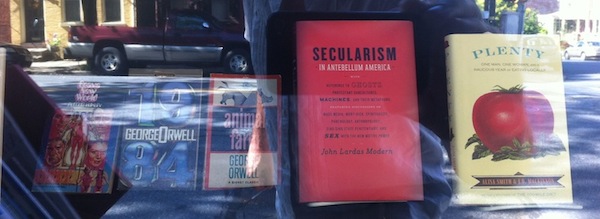
Few books in the field of American religious history have received more attention over the last two years than John Modern’s Secularism in Antebellum America. The bulk of the debate centers on Modern’s understanding of secularism and his argument that mid-nineteenth century American religious movements are in some sense responsible for the secularizing ethos which the majority of them opposed. From Modern’s perspective secularization represents not the separation of the religious from the profane but the opportunity for religion to discover within the secular its true meaning.
Religion thus confronts modernity not by disappearing but inventing modern figures to adapt to the novelty of the technological age, and to redefine itself. Perhaps Modern’s most compelling example of these claims is mid-nineteenth century American evangelicalism—specifically its reliance on modern media and technologies.
These are intriguing claims and those curious in further exploring them will benefit greatly from a recent series devoted to Secularism in Antebellum America on the Religion in American History blog.
In his opening contribution to the series Chad Seales addresses Modern’s paradoxical notion of evangelical secularism: the irony that at the same time evangelicals attempted to withdraw from secular institutions they “generated something like the imperial discourse of secularism—the atmosphere in and through which they recognized and conducted themselves as evangelicals.” This would seem to suggest that evangelicalism derives its crucial semantic elements from a construction of the rejected other—secularism—and depends on the preservation of what it opposes for its own definition.
This is followed by Finbarr Curtis’s contribution, which attempts to unpack the signification of how such terms as secular, liberal, spiritual, and genealogy function in Modern’s approach to the antebellum religion. Curtis’s discussion will be of interest for those intrigued by Modern’s appropriations of Michel Foucault, Talal Asad, Charles Taylor, and Walter Benjamin as well as the extent to which Modern’s book should even be considered a work of history at all.
Also participating in the forum are Kathryn Lofton and Chip Callahan. The latter pushes Modern to clarify the relationship between American Catholicism and secularization by suggesting that Modern’s thesis relies too heavily on Protestant examples. Lofton’s commentary is of particular value: she nicely explains what Modern is really up to by offering such a drastic alternative to standard works of nineteenth century American religious history: to go beyond a surface rendering of history and to indicate the potential covert nexus between the secular and the spiritual. Perhaps this suggests that Modern’s project is ultimately concerned with political theology.
Those trying to grapple with Modern’s aim in Secularism in Antebellum America will be greatly assisted by Paul Johnson’s helpful advice to focus on the secularization thesis that undergirds Modern’s narrative. As Modern puts it, this is a “story, then, of how religion ‘exceeded itself’—extending into therapies, media, ideas of self, social sciences, moral reforms. The religiosity of Protestantism and the secularity of the democratic nation-state came to share an unacknowledged metaphysics. The religious and the secular became compatible.” This would suggest that Modern in some sense embraces Max Weber’s famous argument of a natural affinity existing between Protestantism and secularism. For a fine discussion on the differences between Modern and Weber’s understanding of secularization, readers should consult Michael Warner’s recent response to the book.
The series comes to end with Modern’s reply to his interlocutors in which he clarifies his genealogical approach to the study of history. Here we find Modern candidly explaining the motivation behind his “outrageous and totalizing perspective that a worldview circa 1851 became an objective force.” His genealogical approach to history is an unabashed attempt to understand the present moment by telling a story of how a diverse network of forces—often in opposition to one another—came to shape human consciousness and self-understanding. And for Modern this means that the contemporary moment is haunted by the ghosts of both the religious and non-religious past. Thus for Modern, the secular age is anything but disenchanted.












